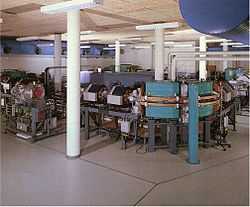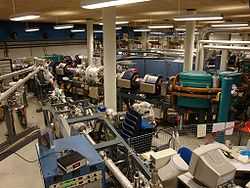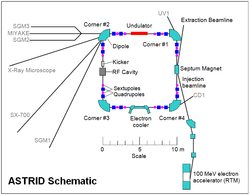ASTRID
Coordinates: 56°10′3.558″N 10°11′54.369″E / 56.16765500°N 10.19843583°E

ASTRID (Aarhus STorage RIng in Denmark) is a particle storage ring at the Department of Physics and Astronomy of Aarhus University. ASTRID was designed, constructed and is operated by the Institute for Storage Ring Facilities in Aarhus (ISA).
History

Designs for ASTRID started in 1985.[1] The original concept for the ring was to store low-energy heavy ions for laser spectroscopic and laser cooling experiments and for atomic collision studies.[2] It was soon realised during the design phase that it would also be possible to store energetic electron beams in the ring and therefore ASTRID could operate as a synchrotron radiation (SR) source, providing photons in the UV to soft x-ray region. In 1988 the Natural Sciences Faculty at Aarhus University was awarded 16.7 M DKK for establishing an Instrument centre in Synchrotron Radiation Research, thus forming ISA. By late 1989 ASTRID was operating in ion storage mode with the first experiments being carried out on laser cooling a stored beam of Li+ ions to 1 mK .[3]

Electrons were first stored in ASTRID in 1991 and by this time two beamlines had been constructed to make use of the synchrotron light, a surface science beamline (SX700) and an x-ray microscope (XM). Ion storage in ASTRID dominated in the early 90s, with many successful experiments storing both positive and negative ions ranging in mass from 1 (hydrogen atom) to 840 (carbon 70 cluster). Meanwhile the synchrotron radiation based research at ISA was expanding, and by 1995 ASTRID was operated 50% of the time in ion storage mode and 50% for synchrotron radiation. With the construction of the Electrostatic Storage Ring for Ions (ELISA) in 1998, and an increasing demand for synchrotron radiation (by 2000 there were 7 beamlines on ASTRID using the light source), the ion storage runs were gradually reduced, until finally in 2005 ASTRID operated in ion storage mode for the last time. Since then ASTRID has been operating in electron storage mode producing synchrotron radiation throughout the year, with 3 or 4 electron runs, separated by shutdown periods for maintenance and development of the ring.
In December 2008, a contract was awarded to design and build ASTRID2, a 46 meter storage ring which will be built adjacent to ASTRID. Rather than having an electron beam which decays over time, ASTRID2 will be continually "topped up" by a feed from ASTRID, allowing nearly constant current.[4] It is expected to be completed by the end of 2011. It will generate synchrotron radiation to provide a tunable beam of light, expected to be of "remarkable" quality, with wavelengths from the ultraviolet through to soft x-rays.
Electron storage

The ASTRID storage “ring”, with a circumference of only 40 m, is actually a square, formed by four sets of two 45 degree dipole bending magnets. There are eight pairs of quadrupole magnets used for horizontal and vertical focusing of the electrons and eight pairs of sextupole magnets for chromaticity correction. Electrons are injected via a septum magnet into the ring from a 100 MeV race-track microtron in 4-5 mA pulses, and captured by a 105 MHz RF system which bunches and accelerates the electrons as they pass through the RF cavity. Many of these pulses of electrons are accumulated at 100 MeV to reach more than 180 mA of current in the ring, which then is accelerated to 580 MeV with negligible loss of beam. The lifetime of a stored beam at 160 mA is 100 to 120 hours.
Technical parameters
The table below shows the typical operating parameters for ASTRID when running in electron storage mode.
| Parameter | Value |
|---|---|
| Maximum Energy | 580 MeV |
| Max. Current (2005) | 286 mA |
| Typical Stored Current | 180–220 mA |
| Lifetime (at 160 mA) | 100–120 hours |
| Horizontal emittance | 0.14 mm mrad |
| RF Frequency | 104.9 MHz |
| No. of bunches | 14 |
| SR critical energy | 0.38 keV |
| Dipole rigidity | 1.9 Tm |
| Quadrupole max gradient | 6.7 T/m |
Beamlines on ASTRID
There are eight operational SR beamlines on ASTRID. The characteristics of these beamlines are summarised in the table below and their location shown in the schematic drawing. Please follow the links in the table for further information and descriptions of the individual beamlines.
| Station | Source | Spectral Range (λ)[nb 1] | Resolving power | Typical flux (1010 photons/sec) |
Applications | ||
|---|---|---|---|---|---|---|---|
| eV | nm | gratings | |||||
| SGM 1 | Bending magnet | 30–650 | 1.9–41 | 3 | 5,000–14,000 | 2 | Surface Science |
| SX700 | Bending magnet | 6–700 | 1.8–205 | 2 | 200–2,500 | 1 | Surface Science |
| XRM | Bending magnet | 410–830 | 1.5–3.0 | 0 | 2,000 | 2 | X-Ray Microscopy, Imaging |
| MIYAKE | Undulator | 15–180 | 6.9–83 | 1 | 2,000 | 20 | Atomic and Molecular Physics |
| SGM 2 | Undulator | 12–40 | 31–105 | 1 | 10,000–20,000 | 20 | Atomic and Molecular Physics |
| SGM 3 | Undulator | 8–150 | 8.3–155 | 3 | 15,000 | 20 | Surface Science |
| UV 1 | Bending magnet | 1.5–12 | 105–830 | 2 | 1,000–5,000 | 20 | CD Spectroscopy, Photobiology, UV Spectroscopy |
| CD 1 | Bending magnet | 1.8–9.9 | 125–700 | 1 | <500 | 100 | CD Spectroscopy |
| |||||||
See also
References
- ↑ Stensgaard, R. (1988). "ASTRID – the Aarhus Storage Ring". Physica Scripta 22: 315. Bibcode:1988PhST...22..315S. doi:10.1088/0031-8949/1988/T22/051.
- ↑ Hangst, J.S. et al. (1992). "Laser cooling of stored ions in ASTRID: A storage ring for ions and electrons". Nuclear Instruments and Methods in Physics Research Section B 68: 17. Bibcode:1992NIMPB..68...17H. doi:10.1016/0168-583X(92)96042-W.
- ↑ Hangst, J. S. et al. (1991). "Laser cooling of a stored ion beam to 1 mK". Physical Review Letters 67 (10): 1238. Bibcode:1991PhRvL..67.1238H. doi:10.1103/PhysRevLett.67.1238.
- ↑ "ASTRID2 – The ultimate synchrotron radiation source". Institute for Storage Ring Facilities. 3 September 2009. Retrieved 2009-01-31.
- ↑ "Beamlines on ASTRID". Institute for Storage Ring Facilities. 13 June 2009. Retrieved 2012-04-01.